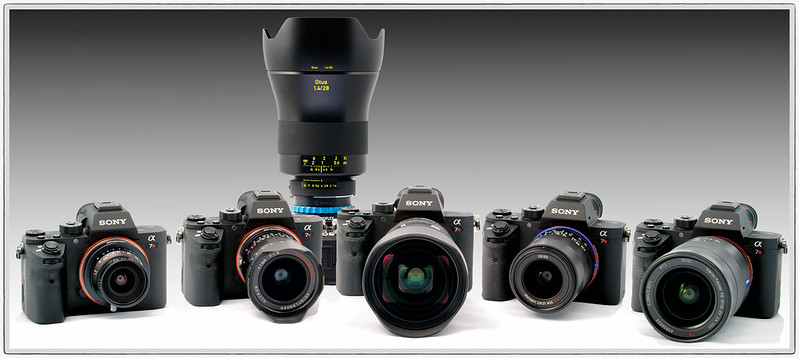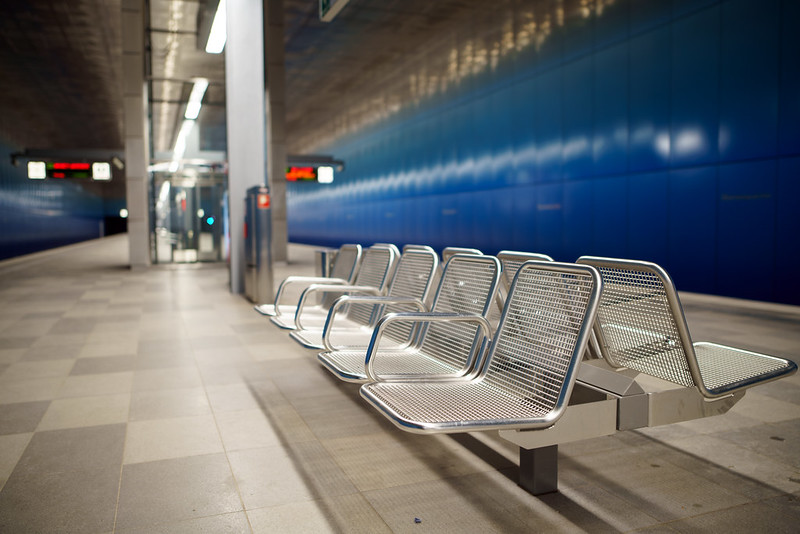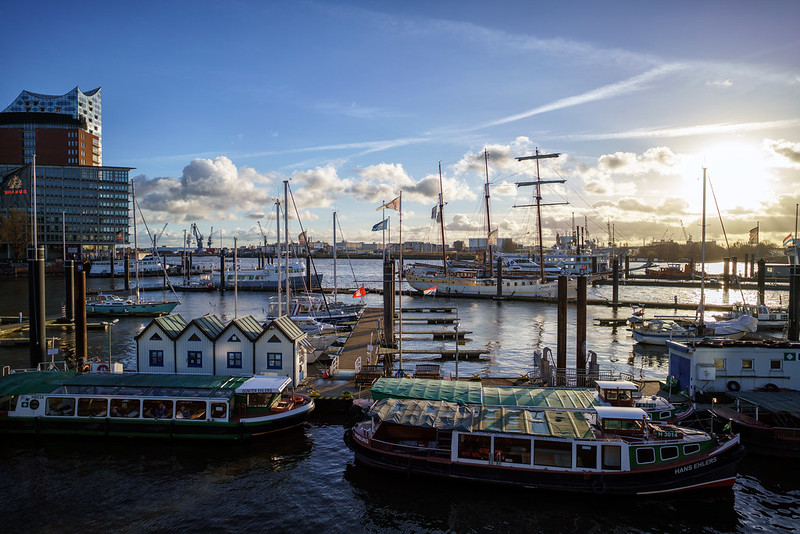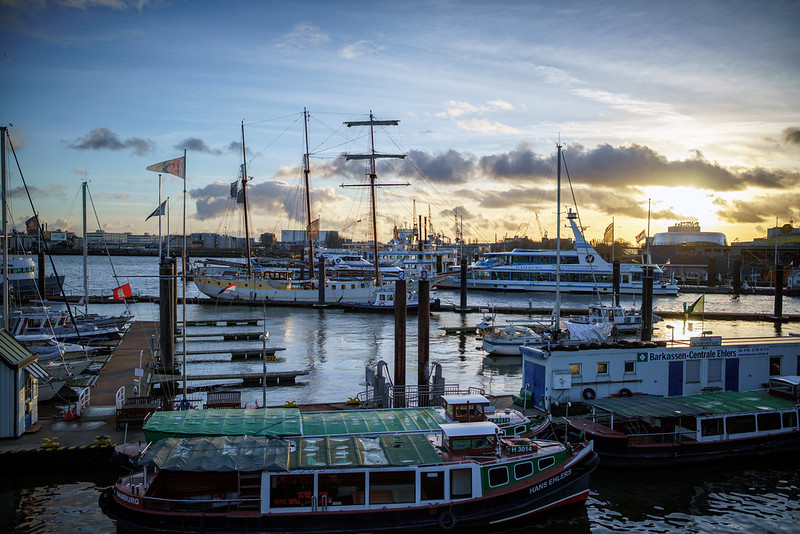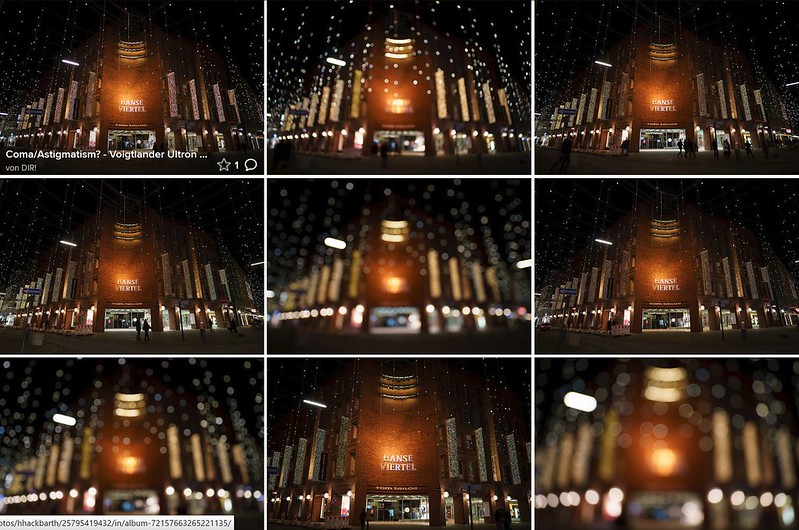End of 2015 / early 2016 a couple of new (ultra) wide angle lenses entered the full frame market. Time to compare them to some candidates you might already know by yourself or from an earlier review on this site. Comparison was done using the Sony A7RII:
From left to right:
- Voigtlander Color Skopar 21mm f/4 (M-mount adapted using Novoflex adapter)
- Voigtlander Ultron 21mm f/1.8 ASPH (M-mount adapted using Novoflex adapter)
- Zeiss Otus 28mm f/1.4 (in the background, ZF.2 version adapted with mechanical Novoflex adapter)
- Sigma Art 20mm f/1.4 (Canon EF mount, adapted using Metabones IV adapter)
- Zeiss Loxia 21mm f/2.8 (native FE-mount, new Distagon design)
- Sony/Zeiss FE 16-35mm f/4 OSS used at 21mm (native FE-mount)
To warm up with this focal length, let's see some examples. Clicking on the images will open the corresponding photo page providing higher resolutions (including full camera resolution):
Sharpness-Tests, Flares, Fall-off
In the first run we compare sharpness at open aperture and at f/11, which you might prefer for architecture / landscape work. As these pictures were taken against the evening sun light, we may also discover flares provided by some candidates.
Voigtlander Color Skopar 21mm f/4
This lens is amazingly small, includig adapter it weighs only about 150g. That's why I prefer flying it on a drone for aerial videos like this. But as you can imagine, this comes for a price as border sharpness is mediocre, it has a strong light fall-off and it provides many kinds of aberrations.
If you look at a 100% crop (actual pixels) from the left border and from the center, you see what I mean:

At f/11 the border and edge sharpness significantly increases, but the tendency to flares increases as well:
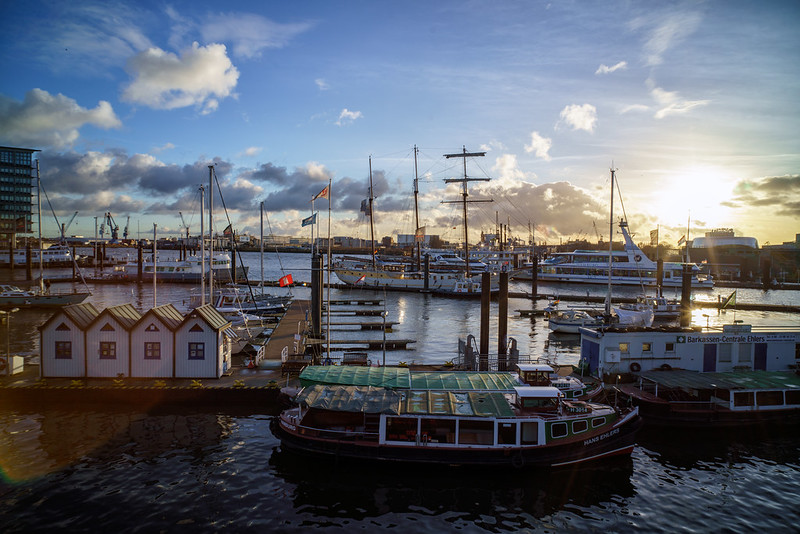
Skopar-Flares when shooting against the light
If you like to play with flares, the Color Skopar 21/4 may be THE lens for you as you can see in this video:
Voigtlander Ultron 21/1.8 ASPH
The full size samples can be found here:
F1.8: https://www.flickr.com/photos/hhackbarth/25623978180/sizes
F11: https://www.flickr.com/photos/hhackbarth/25288496433/sizes
If you look at the center and border crops at f/1.8, you will notice some purple fringing in the center and quite soft borders:
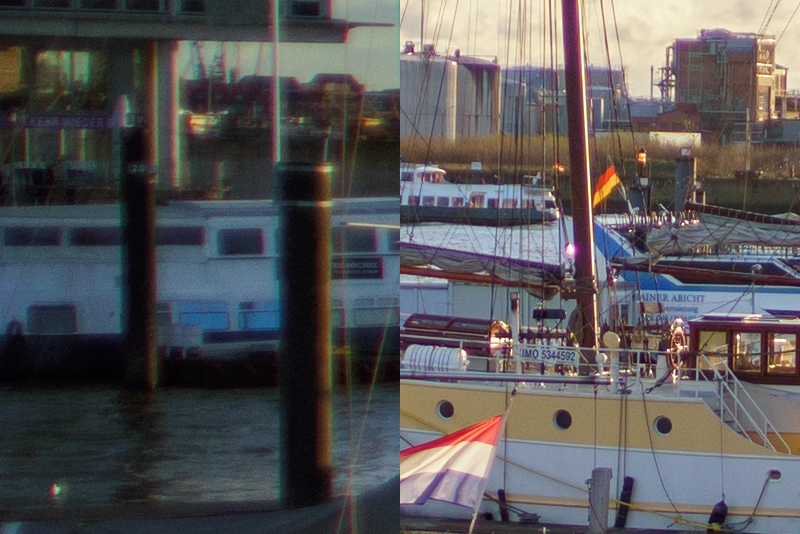
Crop from left border and center Voigtlander Ultron 21/1.8 @ F1.8
At f/11 the results are quite acceptable but there is still a visible field curvature towards the borders.
Sigma Art 20mm f/1.4
The new Sigma Art 20/1.4 is one of the most extreme wide angle designs available now for Canon EF and Nikon F mount. I used it with the Metabones IV adapter which provides AF, aperture control and EXIF data electronically on the A7RII. The full size samples can be found here:
F1.4: https://www.flickr.com/photos/hhackbarth/25822831261/sizes
F11: https://www.flickr.com/photos/hhackbarth/25796936272/sizes
At open aperture it provides already good center sharpness with a little bit of purple fringing but towards the borders you may notice some softness and CAs:
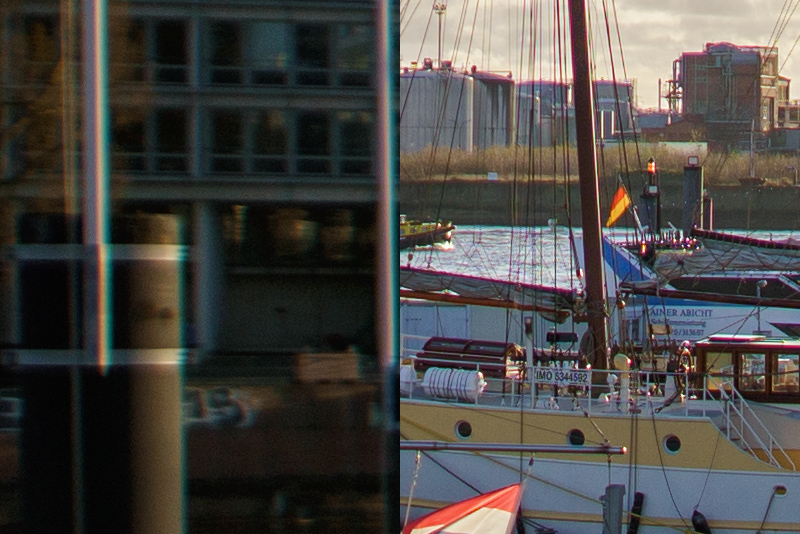
Sigma Art 20/1.4 border and center crop @ F1.4
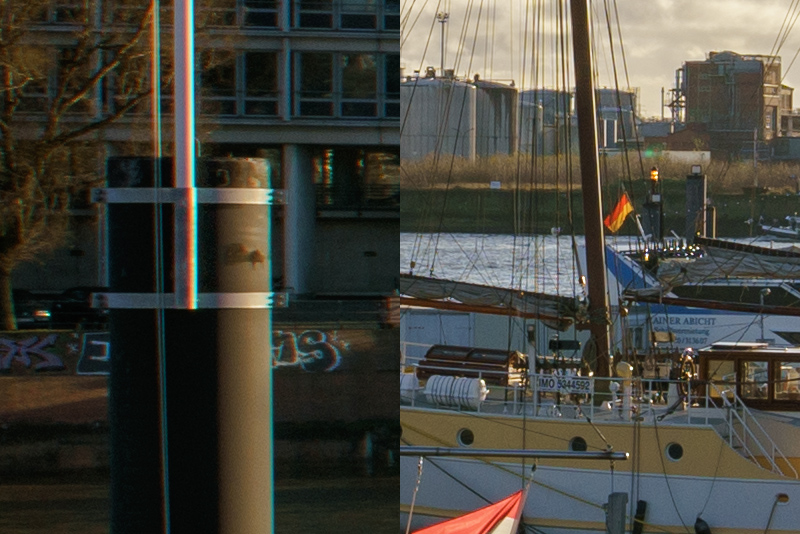
Sigma Art 20/1.4 border and center crop @ F11
At f/11 you may notice also some minor flares and CA, even then it is not the lens I would prefer for landscape or architecture work.
Sony/Zeiss FE 16-35mm f/4 OSS @ 21mm
Full size examples from this well known allrounder at 21mm can be found here:
F4.0: https://www.flickr.com/photos/hhackbarth/25617075390/sizes
F11: https://www.flickr.com/photos/hhackbarth/25616714200/sizes
As we noticed already in earlier reviews, the Sony/Zeiss 16-35 wide angle zoom performs very well right from open aperture (f/4 in that case) even without applying lens profiles:
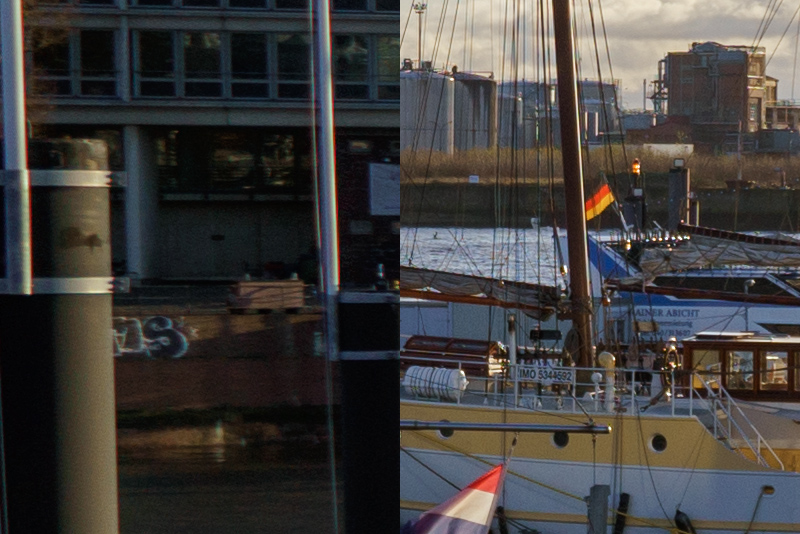
Border and center crop Sony Zeiss 16-35mm @ 21mm @ F4.0
CA are well controlled (may be there is already some electronic tweaking although lens correction profile was not activated in Adobe Camera Raw) and it is quite difficult to produce lens flares with this lens.
Zeiss Loxia 2.8/21
The scene taken with the new Loxia 21 looks simply beautiful. Although there is some light fall-off towards the edges es well, it has a rich color rendering and perfect contrast already at open aperture:
You can find the full size samples of the Loxia here:
F2.8: https://www.flickr.com/photos/hhackbarth/25796802262/sizes
F11: https://www.flickr.com/photos/hhackbarth/25891604696/sizes
When we take a look at the border and center crops at F2.8, this get's confirmed:
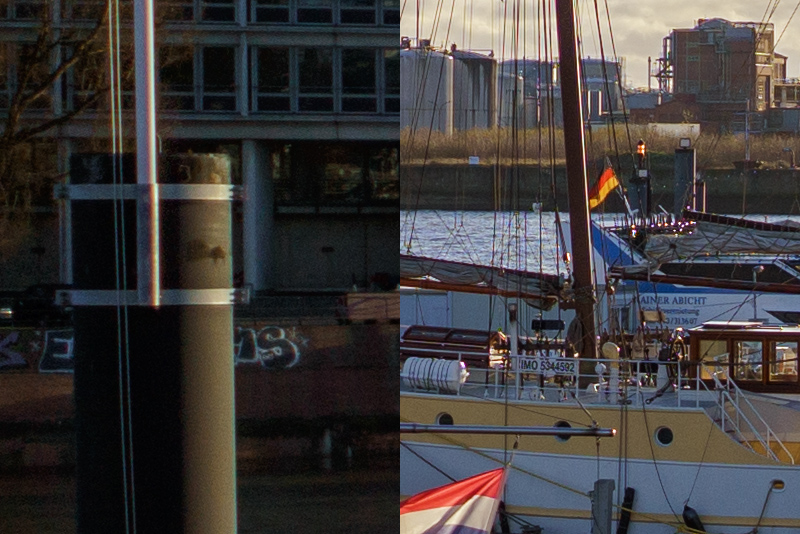
Border and center crop Zeiss Loxia 2.8/21 @ f/2.8
Stopping down to F4 will reduce vignette and increase resolution a litte bit, stopping further down will give you no significant advantage - at least not on a 42 MP sensor. It was also almost impossible to create lens flares. This lens is close to perfection on the A7RII.
Zeiss Otus 1.4/28
Can the Loxia be topped? Propably not at 21mm but at 28mm we have the Otus...
Due to the sun setting down further and the reduced viewing angle, I had to move the tripod a bit in order to keep the sun still inside the frame.
Full size samples:
F1.4: https://www.flickr.com/photos/hhackbarth/25917423485/sizes
F11: https://www.flickr.com/photos/hhackbarth/25288643453/sizes
Crops at open aperture (F1.4):
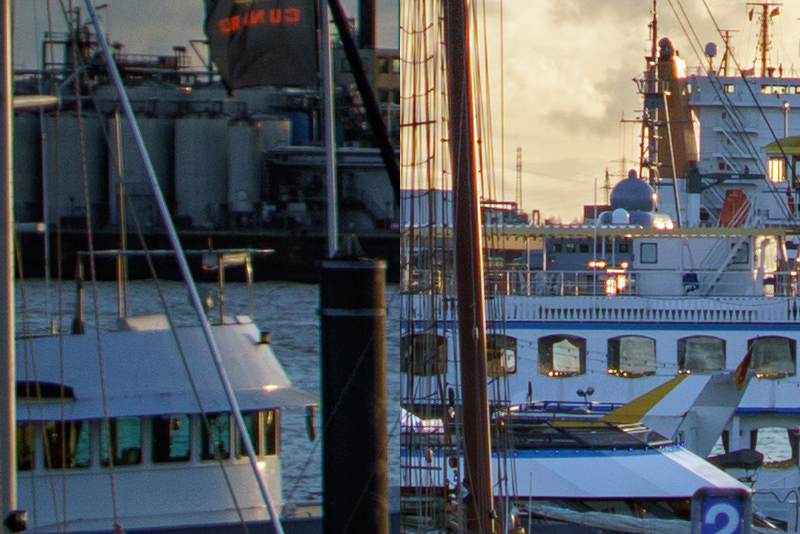
Border and center crops with Zeiss Otus 1.4/28 @ F1.4
Stopping the lens further down surprised me a little bit. Where the Otus 1.4/55 and 1.4/85 already seemed to outperform the sensor from edge to edge even at f/2 to f/2.8, it takes up to f/5.6 (borders) and f/8 (edges) to get really perfect sharpness from corner to corner with the Otus 1.4/28. At least that was my finding on the A7RII, it may behave different on other sensors as it is not that much optimized for the filter stack of the Sony A7 series like the Loxia 2.8/21. But even this level of perfection needs a lot of glas when it has to deliver already at f/1.4. Together with an adapter, the Otus weighs about 1.4 kg - almost 10 times the Color Skopar 21/4 (including adapter).
Edge Sharpness
I decided to not bore you with further 120 sharpness testsamples. You can find an album here that goes through aperture series from open aperture to f/11 for all six candidates. The images were taken from a tripod with self-timer and the camera was rotated so that you have detailed structures in the very outer edges. For convenience the series will also provide 100% crops (1:1 actual pixels) for the center and both edges so that you do not have to scroll into each image by yourself: https://www.flickr.com/x/t/0097009/gp/hhackbarth/5507TD/
Bokeh, "Pop"
Ultra wide angles and bokeh? Well, not the typical application - but in this test we have several candidates that seem to make possible with a full frame sensor which seemed to be reserved for medium format cameras so far: playing with a shallow depth of field not only for close-ups.
Easy finding is, that the widest margin is provided by the Zeiss Otus 1.4/28, the Sigma Art 20/1.4 and the Voigtlander Ultron 21/1.8 (in that order). You find some examples already in "warm up" photos at the beginning of this article. Here are some further examples:
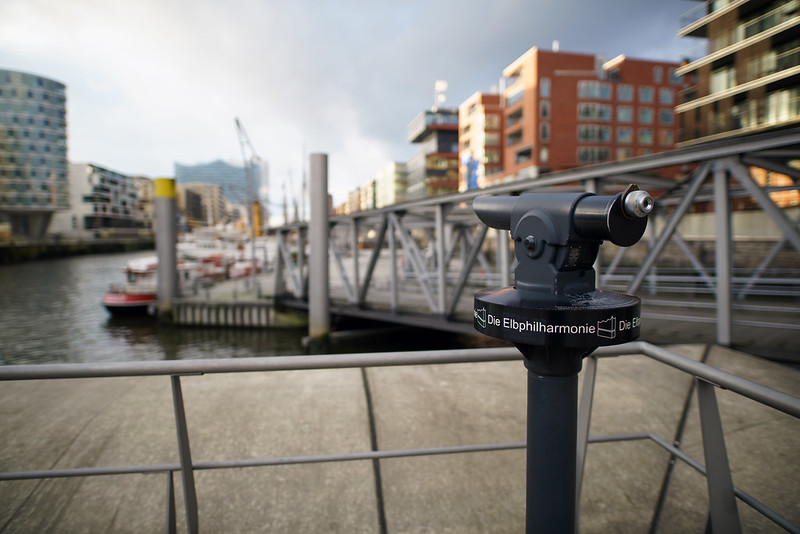
Bokeh, 3D-Pop of the Sigma Art 20/1.4 @ F1.4

Sharpness & Bokeh of the Zeiss Otus 1.4/28 @ f/1.4
In the previous "Octopus" example of the Otus you will also find an incredible level of detail in the sharpness focal plane. It is worth to click on that image in order to pixel-peep into the full resolution! This is what makes up the Otus line: Crisp details and butter smooth bokeh at F1.4!
If you would like to compare with the Ultron 21/1.8, voilà!

Sharpness & Bokeh of the Voigtlander Ultron 21/1.8 @ F1.8
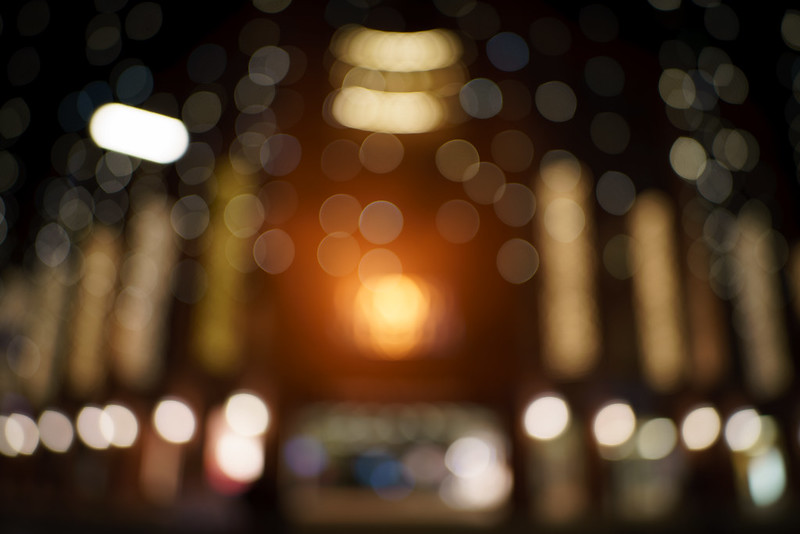
Night-Bokeh of the Zeiss Otus 1.4/28 @ F1.4

Bokeh of the Zeiss Otus 1.4/28 @ F1.4
The Loxia 2.8/21 is not a typical bokeh lens but if you get close enough, there are still some options to play with DOF:
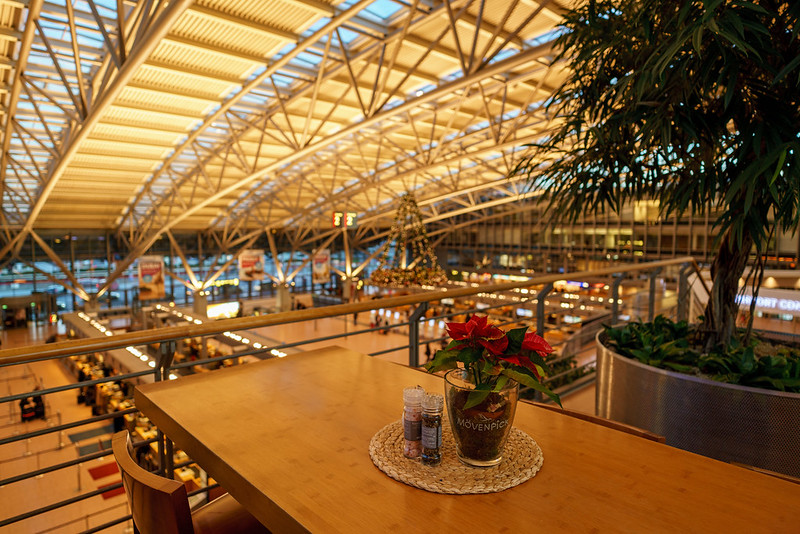
Bokeh of the Zeiss Loxia 2.8/21 @ F2.8
You find a bokeh comparison series covering all candidates with the same scene starting from the picture in this link:
https://www.flickr.com/photos/hhackbarth/25795988062/in/album-72157663265221135/
Coma, Astigmatizm
If you like to take photogaphs of stars & night skies, you may be interested in the level of optical aberrations of the candidates in the borders and edges. The sharpness series shown above may already give you an impression. Here you find another series with a kind of star field simulation, providing shots in and out of focus (for night bokeh comparison as well):
https://www.flickr.com/photos/hhackbarth/25795419432/in/album-72157663265221135/
As an example you find here the upper left edge of the shots using the Voigtlander Ultron 21/1.8 and the Loxia 2.8/21:
Although the light sources (halogen light bulbs) were not perfect punctual like stars, you can get an idea about the aberrations you will see with these lenses. In my opinion, the Zeiss Loxia will give you the best results, if you can live with f/2.8.
Conclusion
Each of these lenses is special and has particular advantages as well as weaknesses.
- The Color Scopar 21/4 is unbeatable in terms of size and weight but adapted on the A7 series you will have to stop it down to about f/11 in order to get acceptable borders and edges.
- The Ultron 21./1.8 delivers a good compromise between size, weight and low light performance. It provides you options to play with shallow depth of field but it suffers of a strong field curvature (not only on A7 series sensors).
- The Sigma Art 20/1.4 is at the moment the shortest F1.4 full frame ultra wide angle lens and it provides a fast autofocus which helps significantly when you shoot at open aperture and want to play with shallow depth of field - which will propably be the main reason why you may take it into account. The border and edge performance are only mediocre on the A7RII - even stopped down to f/11, which is acceptable if you take into account the attractive price tag as well.
- The Sony/Zeiss FE 16-35mm f/4 OSS zoom is the perfect all-rounder. It covers a wide focal range, delivers excellent results already at f/4, has a good resistence against back and stray light, gives you autofocus and OSS. Although it is quite large, it comes with acceptable weight. For me it is the perfect travel lens.
- The Zeiss Loxia 2.8/21 is propably the best compromise between size, weight, low light capability and optical performance. It is a perfect fit for the A7-series, has excellent edge and border performance right from open aperture, rich colors and contrast, excellent back and stray light resistance due its perfect coating and it has a weather sealing. Some users critisize that there is only a small part of the barrel that you can grab when you mount it to the camera body. In the near range, it also provides nice options to play with a shallow depth of field. This little gem seems to be worth every cent you pay for it, if you like the 21mm viewing angle.
- The Zeiss Otus 1.4/28 again underlines the "no compromise" claim. Although to me it seems to be not as perfect at open aperture as the Otus 1.4/55 and 1.4/85, it still seems to be the best f/1.4 lens you can get in the wide angle range. It almost flawlessly provides crisp details with a creamy bokeh right from F1.4. The focus ring moves butter smooth but due to a short focus throw it requires sensitive handling. For this level of perfection you must be willing to handle a bulky 1.4 kg lens which does not give you a well balanced combination when used on the A7-series. When using adapted, you should choose an adapter that provides its own tripod mount.
Please keep in mind that results may vary also between each particular sample of these lenses.




